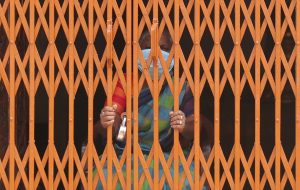India has started to re-open its $5 trillion economy following months of nationwide lockdown. The temporary shutdown has already proved costly on multiple fronts. The unemployment rate soared to double digits, and the loss of livelihoods has increased food insecurity. But for the country’s 600 million women, without corrective policy measures, the impact could be worse.
India has some of the worst gender statistics in the developing world. Its female labor force participation rate is one of the lowest in the world. Among those women who do work, most are in unpaid or irregular work. This employment group, what the International Labor Organization calls “vulnerable employment,” has been hit the hardest during the pandemic. Many women are thus at risk of a permanent exit from the labor market.
The end result will be the feminization of income poverty. Research from the World Bank suggests the pandemic will drive more than 12 million Indians into poverty. Women are likely to be over-represented among the new poor. This can have adverse effects on household wellbeing and food security for adolescents and small children. It would also mean lower schooling and poorer health outcomes in the next generation.
Food and nutrition insecurity indicators always worsen during economic crises. But as food shortages emerge and prices rise, gender inequality also worsens. Patriarchal cultural traditions reinforce existing inequalities in food and resources distribution within the household when supplies are short.
Gender inequality in food security will increase further following the loss of employment income. Short-term malnutrition will also rise. The end result would be many women’s permanent exclusion from the labor market and government workfare schemes. This risks creating a new cycle of poverty among working-class women. Poor health may stop many from returning to work when the economy fully reopens.
Beyond reduced food consumption, the pandemic will widen gender inequalities in access to healthcare. According to government data, 55 percent of women report not using public health services. Out-of-pocket health expenditures are high. Only one-third of households have at least one member covered under any health insurance, which also exhibits a clear gender bias.
Young girls, adolescents, and adult women remain at greater risk of exclusion from the health system even after the pandemic. Evidence shows that parents invest first and to a greater degree in boys than in girls, thereby increasing gender inequalities.
Protecting women’s employment, health, and food security during the pandemic is of critical importance. Yet the COVID-19 outbreak has undermined safety net provisions safeguarding women’s well-being.
Several schemes that served as critical delivery platforms for women’s health and nutrition interventions have been suspended during the lockdown period. Recent survey reports show sharp post-lockdown declines in the use of reproductive and post-natal cash and in-kind transfer schemes such as the Janani Suraksha Yojana and the Janani Shishu Suraksha Karyakram. Under the Integrated Child Development Scheme (ICDS), the country’s 1.3 million Anganwadi centers provide critical nutrition counselling and supplementary food to pregnant and lactating mothers; these centers have been closed since March 24. Though several states have since begun doorstep delivery of supplementary nutrition, other services, like immunizations, remain suspended.
COVID-19 has also disrupted contraceptive supply chains. The ban on the export of progesterone and the halt in production of IUDs in India has further restricted women’s already limited access to birth control – in 2015-16, only slightly over half of women aged 15-49 used any form of contraception. This means a likely rise in unwanted pregnancies and sexually transmitted diseases in post-pandemic months. The experience of the Ebola and the Zika virus outbreaks showed that the health consequences of such disruption falls disproportionately on women. As they lost control over their sexual and reproductive lives, maternal mortality rose sharply.
The need for social distancing has also temporarily disrupted the functioning of self-help groups (SHGs) that have been credited with improving women’s well-being and empowerment.
Clearly, without policy reinforcement, COVID-19 will only deepen existing social and economic inequalities for Indian women. So, what should be done to fight gender inequality during the pandemic?
We recommend three policy measures that can help women as the Indian economy prepares to open further. First is restoring pre-existing health services and social safety net schemes for women and adolescent girls. Second is creating new institutional provisions that leverage women’s empowerment at the community level. Third is implementing evidence-based recovery policy that uses gender-disaggregated data on employment and health impacts to guide decisions.
Globally, women have always suffered during economic and public health crises. To avoid the same fate, India must adopt a gender inclusive policy planning and implementation to manage the coronavirus pandemic.
M Niaz Asadullah is Professor of Development Economics, University of Malaya, Kuala Lumpur, and Southeast Asia Lead of the Global Labor Organization. Follow him on Twitter @Niaz_Asadullah.
Kalyani Raghunathan is Research Fellow in the Poverty, Health and Nutrition Division of the International Food Policy Research Institute (IFPRI), New Delhi. Follow her on Twitter @kalraghunathan.

































